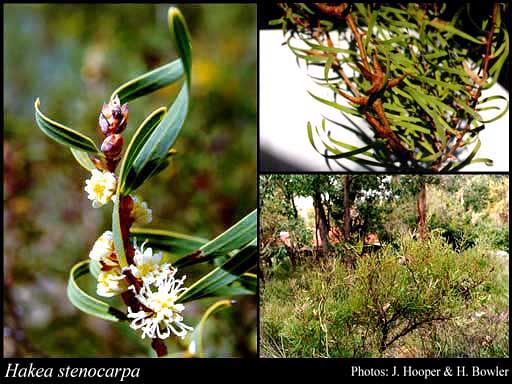- Reference
- Prodr. Suppl. 29 (1830)
- Conservation Code
- Not threatened
- Naturalised Status
- Native to Western Australia
- Name Status
- Current
Rounded, lignotuberous shrub, 0.3-1(-2) m high. Fl. white, Sep to Oct. Gravelly sand or clay over laterite.

Scientific Description
Shrubs, 1 m high; branchlets glabrous or hairy. Leaves alternate, 50-135 mm long, 2-8 mm wide, glabrous; lamina flat, widest around the middle or more or less the same width throughout, entire. Inflorescences axillary, white; pedicels 2-4 mm long. Perianth 4-5.5 mm long, glabrous; ovary glabrous; pistil 4.4-6 mm long, pollen presenter conical, style glabrous. Follicles 25-30 mm long, 6-8 mm wide, corky tetrahedral projections (on external surfaces of fruit) absent; seed 16-17.5 mm long (including wing), 4-6 mm wide, the wing discontinuous, marginal, extending down one lateral side only. Flowers in September or October. Occurs in the South-west (SW) Botanical Province(s), in the Geraldton Sandplains (GS), Swan Coastal Plain (SWA), Avon Wheatbelt (AW) or Jarrah Forest (JF) IBRA subregion(s).
Distribution
- IBRA Regions
- Avon Wheatbelt, Geraldton Sandplains, Jarrah Forest, Swan Coastal Plain.
- IBRA Subregions
- Dandaragan Plateau, Geraldton Hills, Lesueur Sandplain, Merredin, Northern Jarrah Forest, Perth, Southern Jarrah Forest.
- Local Government Areas (LGAs)
- Armadale, Beverley, Boddington, Busselton, Carnamah, Coorow, Dandaragan, Dardanup, Donnybrook-Balingup, Gingin, Gosnells, Greater Geraldton, Irwin, Kalamunda, Koorda, Mingenew, Mundaring, Murray, Northam, Serpentine-Jarrahdale, Toodyay, York.